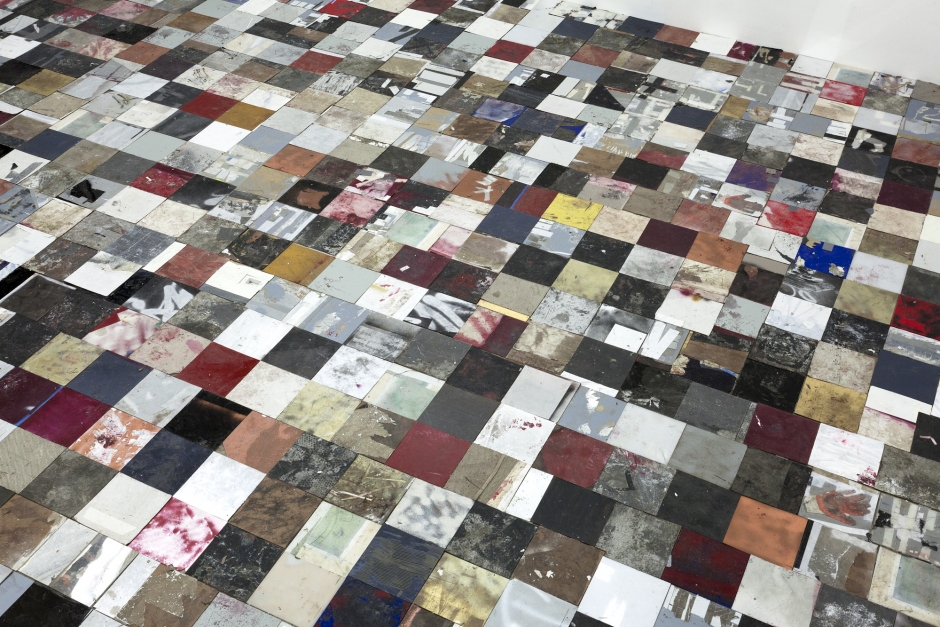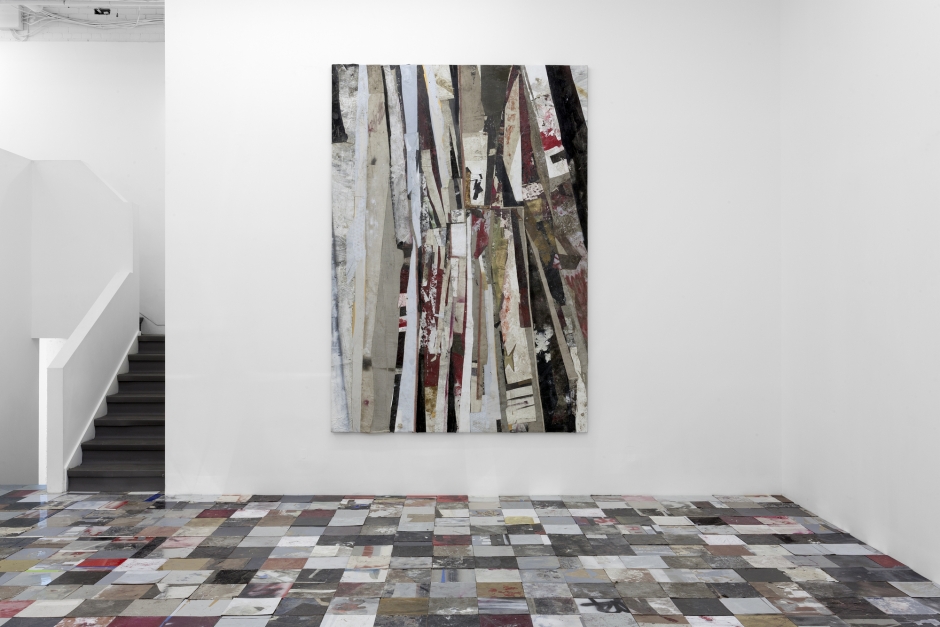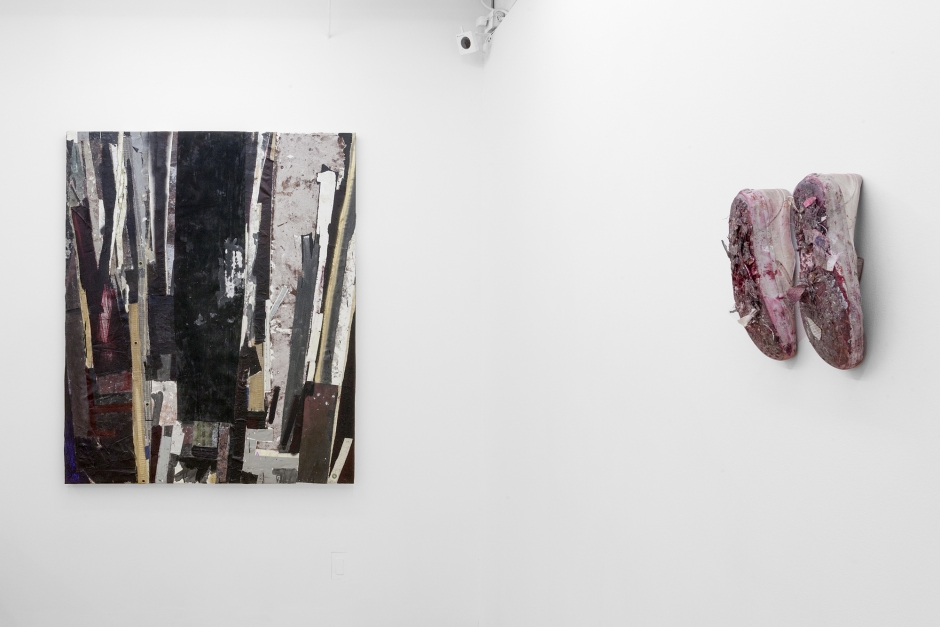Imagine that every bit of detritus on which you stepped throughout the day stuck to the bottom of your shoes. What would you produce from the dredges? Ryan Wallace’s tiles and collages are blue-collar fossils of everyday materials found in his studio including jeans, work gloves, mirrors, gold foil, spray paint, glue and tape residue, shoe prints and canvas strips.
The collection of tiles titles “Pitch” (2016) covering the main floor of Cooper Cole gallery – reminiscent of the metal tiles by minimalist artist Carl Andre – are calculated residue from Wallace’s sculptural process. The Plexiglas tiles were originally used as molds to fill with rubbish and plaster producing white plinth-like cubes with only a hint of their dirty contents. The cubes are not exhibited with the tiles in this specific manifestation. The accidentally visually appealing squares are not displayed as residue of Wallace’s cubes, they are artworks in their own right and their mosaic installation across the floor implicates the visitors into direct participation in the space. The pieces of debris are well stuck to the tiles, but the effect is that of a dirty linoleum floor in much need of a sweep.
 Ryan Wallace, Pitch, 2016, detail. Image courtesy of Cooper Cole Gallery
Ryan Wallace, Pitch, 2016, detail. Image courtesy of Cooper Cole Gallery
Wallace’s works on canvas “Dragnalus I” (2015) and “Dragnalus II” (2014) are collages of left over materials and cut offs. The strips of paint and fabric in shades of grey, brown and red are set side by side producing a pattern of hardwood floor, plywood board, aerial views of farm land, or painterly abstractions of birch trees. But unlike pallets of leftover paint accumulating layers of colour that would never become works, the recycled strips of polyester and vinyl covered in rubber, oil, acrylic, wax and various metals are again validated artworks. It leaves one to wonder from what process Wallace produces these cut-offs if the only evidence of his work is constructed purely from leftovers. A possible creative answer is inspired by his “Untitled” sculpture (2016) a pair of shoes covered in red gunk.
 Installation view with Ryan Wallace, Dragnalus I, 2015, enamel, acrylic, fabric, vinyl, steel aluminum, rubber, linen on canvas (on the wall) and Pitch, 2016, Plexiglas, oil, enamel, acrylic, vinyl, rubber, aluminum, tape, Masonite, polyester, canvas (on the floor). Image courtesy of Cooper Cole Gallery
Installation view with Ryan Wallace, Dragnalus I, 2015, enamel, acrylic, fabric, vinyl, steel aluminum, rubber, linen on canvas (on the wall) and Pitch, 2016, Plexiglas, oil, enamel, acrylic, vinyl, rubber, aluminum, tape, Masonite, polyester, canvas (on the floor). Image courtesy of Cooper Cole Gallery
Hung on the wall of the upstairs space, the soles of the shoes face out displaying scrap bits of metal and fabric like the pieces in his larger works insinuating a performative process. If we imagine these shoes were worn by Wallace at work in his studio, we can also imagine that his artistic practice is one of secret active performance in which the work constitutes the act of producing crusty artistic dredges, and the works displayed might be considered documentation of his performance. Regardless of the method by which Wallace procures the cast off materials, the exhibition Dragnalus provides much for the eye to explore. New-York based Ryan Wallace’s first Canadian solo exhibition provides a glimpse into the work and process of an accomplished recycler of industrial, utilitarian materials.
 Installation view with Ryan Wallace, Dragnalus II, 2014, oil, enamel, lead, aluminum, canvas, polyester, vinyl, silicone, rubber,pigment, wax on canvas (left) and Untitled, 2016, mixed media (right). Image courtesy of Cooper Cole Gallery
Installation view with Ryan Wallace, Dragnalus II, 2014, oil, enamel, lead, aluminum, canvas, polyester, vinyl, silicone, rubber,pigment, wax on canvas (left) and Untitled, 2016, mixed media (right). Image courtesy of Cooper Cole Gallery
Alice Pelot
*Exhibition information: January 22 – February 20, 2016, Cooper Cole Gallery, 1134 Dupont Street, Toronto. Gallery hours: Wed – Fri: 1 – 6 p.m., Sat: 11 a.m. – 6 p.m.
